What is the Best Explanation for the Fine-Tuning of the Universe for Life?
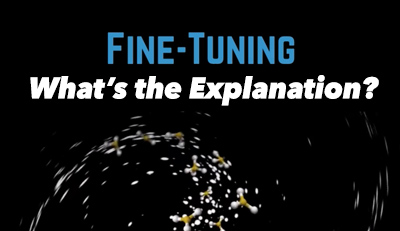
Since the 1950s and 1960s, the term “fine-tuning” has emerged as a scientific concept referring to the narrow range of certain constants and quantities that appear necessary for the formation of life in our universe. Many have pointed out that the initial conditions of the universe were such that they made life, including intelligent life, possible.[1] Over the years, fine-tuning has become a topic of growing interest among scientists, philosophers, and theologians.[2]
While the term “fine-tuning” was initially considered religiously neutral, the appellation now incites great debate between those who view it from a theistic perspective and those who regard it as a characteristic of a naturalistic universe. The former group suggests that the existence of fine-tuning should lead us to believe that some form of intelligence has designed the universe, while the latter believes it to be an observed yet not necessarily remarkable feature of a universe resulting from chance.
The Possibility of Life in the Universe
For our purposes, “life” can be defined as any organism that can take in food, extract energy, grow, adapt to its environment, and reproduce. Thus, when scientists assert that a universe is “life-permitting,” they mean that the conditions that enable life must exist, at least somewhere in the universe. The existence of life-permitting conditions does not mean that life will necessarily arise; it means only that there exist conditions that make it possible.
In 1974, theoretical physicist Brandon Carter introduced the anthropic principle, which asserts that the presence of intelligent observers in our universe implies that the conditions that give rise to intelligent life must exist in the universe. Obviously, since the Earth is life-permitting, we shouldn’t be surprised to observe intelligent beings.[3] Nothing earth-shaking in such an observation; or is there?
What is Fine-Tuning?
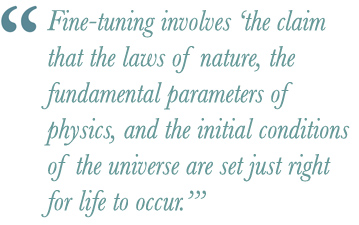
Within the context of a life-permitting universe, fine-tuning refers to “the claim that the laws of nature, the fundamental parameters of physics, and the initial conditions of the universe are set just right for life to occur.”[4] In other words, certain physical constants and quantities must exist within an exceedingly narrow range to enable the appearance of life. As physicist Luke Barnes states, “In the set of fundamental parameters (constants and initial conditions) of nature… an extraordinarily small subset would have resulted in a universe able to support the complexity required by life.”[5]
There are three commonly-mentioned categories of fine-tuning observed in the universe: (1) the fine-tuning of the laws of nature (e.g., gravitational force, strong nuclear force), (2) the fine-tuning of the constants of physics (e.g., the gravitational constant G, electromagnetic constant), and (3) the fine-tuning of the initial conditions of the universe (e.g., low entropy state).[6]
Many have suggested that even the tiniest change to any of these constants or quantities would have resulted in a universe incapable of supporting life. For example, if the gravitational fine structure constant (a measure of the strength of the interaction between charged particles and the electromagnetic force) had been slightly smaller, existing matter in the universe would have expanded too far and too fast to form stars and planets. Hence, no life could have formed. On the other hand, if the gravitational value were somewhat larger, the expansion of the universe would have continued to slow down until it collapsed on itself. The stars would have burned out too quickly to allow the evolution of life.[7] Moreover, if the electromagnetic force did not exist, there would be no complex chemistry.[8] In other words, the chemicals essential for life would have been too unstable to allow proper bonding, and the amounts of carbon and oxygen would have been insufficient to support life.
While many believe that the observed parameters are finely tuned to allow for intelligent life, others have suggested that it is impossible to scientifically test the hypothesis of fine-tuning, as it is impossible to adjust the values. As physicist Sabine Hossenfelder has stated, a fine-tuned universe represents “an observational constraint on our parameters.”[9] In other words, our knowledge of fine-tuning is interesting but of limited scientific value since the parameters cannot be changed to observe the consequences.
Given the diverse views on the significance (or insignificance) of fine-tuning, it seems prudent to understand the various explanations for this phenomenon. The rest of this paper will discuss and evaluate three of the more common explanations for fine-tuning.
What is the Best Explanation for a Fine-Tuned Universe?
There are three popular explanations for a fine-tuned (i.e., life-permitting) universe: (1) the multiverse hypothesis, (2) single-universe naturalism (i.e., the claim that fine-tuning is a brute fact of a universe brought about by chance), and (3) the design hypothesis (i.e., that a super-intellect designed the universe).[10]
The Multiverse Hypothesis
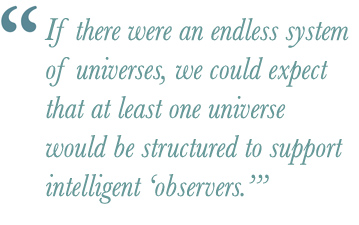
Explanation. This hypothesis proposes the existence of a vast, if not infinite, number of universes with different initial conditions and fundamental physical boundaries (and perhaps even different laws of nature).[11] According to this hypothesis, if there were an endless system of universes, we could expect at least one universe to be structured in a way that supports the possibility of intelligent “observers.” Thus, we shouldn’t be surprised to find embodied conscious agents somewhere in a multiverse. It is enough to know that we were randomly selected to live in a universe that supports intelligent life.
Evaluation. One problem with the multiverse hypothesis is that it lacks empirical evidence to support it. If multiple universes exist, they are unobservable since, as physicist Sabine Hossenfelder tells us, any universes outside our own are “causally disconnected from us.”[12] Hossenfelder concludes: “The vast majority of multiverse ideas are presently untestable, and will remain so eternally.”[13] With no data forthcoming, one cannot currently test this view, and without observation and testing, there is no way to generate empirical evidence to support the multiverse hypothesis. Ultimately, the multiverse explanation is not a scientific hypothesis; it is a philosophical (i.e., metaphysical) one. Philosophical questions such as the multiverse hypothesis lie outside the purview of traditional scientific methods and must be justified in some other manner.
A second problem with this hypothesis is that the appearance of life in any purported alternate universes would be just as improbable as in our own. If all universes in a multiverse are causally disconnected, then the probability of achieving life in one universe is no different than any other. For each independently functioning universe in a multiverse, there would be an infinite number of possibilities for the initial constants. Every time you roll a die, you get the same probability of seeing any number. Similarly, every time a new universe appears, the probability that the constants and quantities will be finely tuned for life is the same: extremely improbable.
On the other hand, advocates of the multiverse often postulate a fundamental connection between the universes. That is, they propose that a universe-generating mechanism explains the origin of all universes in a multiverse.[14] By postulating a universe generator, proponents think that it may increase the probability of a life-friendly universe somewhere in the multiverse.[15] However, the cosmologies that are responsible for generating multiple universes (i.e., string theory and inflationary cosmology) are highly speculative theories that invoke mechanisms that themselves require fine-tuning.[16] Thus, the multiverse hypothesis cannot explain fine-tuning without appealing to speculative theories as well as to a prior fine-tuning mechanism (either a universe generator or whatever may have generated the generator). This leads to an infinite regress problem: How do you explain an egg without a chicken?
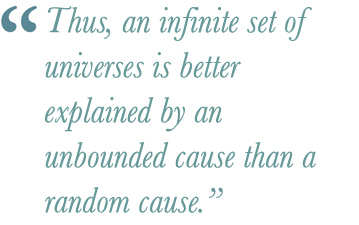
For example, suppose one tries to explain the design of a car by referring to the assembly plant where the car is produced. An assembly line in a car plant does not eliminate the need to explain the car’s design. If anything, it merely points to the need for an explanation of the design of the assembly plant that produces the cars. In other words, it shifts the explanation to a prior level. Thus, the multiverse approach lacks an explanation for all preceding links in the universe-generating process.
Single-universe Naturalism
Explanation. The single-universe naturalism hypothesis suggests that there is nothing surprising about the fact that we find ourselves in a universe with rational beings because nothing else is possible. Only in a universe that supports life can there be beings capable of observing and reflecting upon fine-tuning. Single-universe naturalists see a life-permitting universe as a brute fact that requires no further explanation. No one would be alive to comment on fine-tuning if the universe were not life-permitting. Therefore, the existence of human observers is to be expected and is unremarkable.
Proponents who see fine-tuning as a brute fact say we don’t need to search for a deeper or more fundamental explanation. The universe “just is.” If the existence of fine-tuning in the universe is the result of chance, then any arrangement of matter and the appearance of life is equally probable (or improbable). There is no need to seek a deeper meaning.
Evaluation. First, to say that fine-tuning “requires no further explanation” is a matter of opinion. Undoubtedly, many people seek deeper explanations than are readily available. And to say that human existence is “unremarkable” is, at best, arguable.
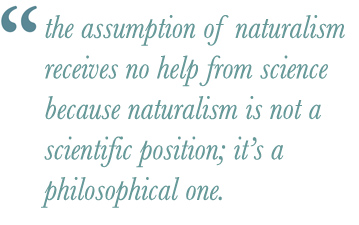
Second, this hypothesis is grounded in a belief system known as philosophical naturalism (or, simply, “naturalism”).[17] However, assuming the truth of philosophical naturalism does not make it true. Philosophical naturalism receives no support from science because it is not a scientific position, but rather a philosophical one. Assuming the truth of naturalism can be considered a form of “naturalism-in-the-gap,” a belief that naturalism is probably true and will likely explain such questions as fine-tuning, given enough time. However, this view lacks evidence and arguments to demonstrate its rationality.[18]
Whenever someone assumes the truth of a philosophical position, they naturally begin to reject anything that does not fit their predetermined viewpoint. As candidly admitted by evolutionary biologist Richard C. Lewontin (1997), many people take the side of naturalism simply because of a prior commitment:
It is not that the methods and institutions of science somehow compel us to accept a material explanation of the phenomenal world, but, on the contrary, that we are forced by our a priori adherence to material causes to create an apparatus of investigation and a set of concepts that produce material explanations, no matter how counter-intuitive, no matter how mystifying to the uninitiated.[19]
In summary, single-universe naturalism is based on a philosophical position that presupposes that only physical reality is objective. Adherents of this position see fine-tuning as a brute fact that needs no explanation. However, this philosophical belief system cannot be justified by assumption, and philosophical arguments in favor of this position are scarce.
The Design Hypothesis
Explanation. For many theists, it is unsurprising that the universe appears to be fine-tuned for intelligent life. After all, if an intelligent being exists that wants (and has the power) to create a world where intelligent life exists, it seems reasonable that such a being would set the initial conditions and physical constants of the universe to favor that outcome. A finely tuned universe—one that supports intelligent, self-reflective, rational beings—is perfectly consistent with a theistic explanation. It represents a coherent and simple explanation that does not require an appeal to unnecessary conjectures (e.g., the multiverse or brute facts) to support its case.
Theists (specifically monotheists) have historically believed that God created the universe and populated it with all forms of life, including intelligent life. This has inspired many theists, as well as non-theists, to seek answers to the “how” question through the study of biology, chemistry, and physics. In a theistic world, the Designer could have used any number of methods to ensure the appearance of intelligent life, including a fine-tuned single universe or even a multiverse.
The design hypothesis does not require a theistic God or gods. Instead, it may be that intelligent beings from elsewhere in the universe were wholly or partially responsible for the Earth’s living conditions. However, at this point, there is little evidence to suggest the existence of intelligent life in other parts of the universe.
Evaluation. Like the multiverse and single-universe naturalism hypotheses, the design hypothesis cannot be proven scientifically. Indeed, a design explanation is not a scientific position but a philosophical or theological one.
The plausibility of the design hypothesis can be improved by providing evidence for the existence of a supernatural, intelligent being. In this sense, theism receives support from various theistic arguments, including the cosmological argument, the moral argument, the ontological argument, the teleological argument, and many others. However, before a theist can be rationally justified in believing that a designing intelligence is responsible for a fine-tuned universe, she must first show that one or more of the arguments for the existence of God are likely to be true while also showing that the multiverse and single-universe naturalism (i.e., chance) explanations lack sufficient credibility.
Conclusion
Other explanations for fine-tuning may emerge that are not discussed in this article. Those that have been cited are currently the most common, and each is consistent with a fine-tuned universe. However, none of these hypotheses can explain fine-tuning with absolute certainty. Each person must examine the evidence for themselves and decide which of the hypotheses fits best with the evidence.
Since there is no good reason to believe that a multiverse is or must be randomly caused, and since proposing a multiverse adds complexity to the proposed cause of fine-tuning, a more straightforward (i.e., simpler) explanation seems more likely. In other words, the existence of an intelligent, rational being that caused the multiverse and made possible the appearance of other intelligent beings represents a more straightforward solution. Moreover, a brute fact hypothesis does not provide observational evidence that the universe exists without cause or reason.
The design hypothesis suggests that the finely tuned constants and quantities of the universe favor the influence of a designing intelligence. According to physicist John Polkinghorne, the universe has possessed the potential for life since the Big Bang because of fine-tuning.[20] But why is the universe finely tuned? Polkinghorne states that the universe’s vast collection of finely tuned parameters is too precise to be a “happy accident.” He concludes that fine-tuning leads us past brute facts and toward a context of “deeper intelligibility.”[21] The late English astronomer Fred Hoyle, who was no Christian, may have said it best: “A commonsense interpretation of the [fine-tuning] facts suggests that a super-intellect has monkeyed with physics, as well as with chemistry and biology.”[22]
About the Author
David P. Diaz, Ed.D., is an independent researcher and retired college professor. His writings have ranged from peer-reviewed technical articles to his memoir, which won the 2006 American Book Award. Dr. Diaz holds a Bachelor’s and Master of Science degree from California Polytechnic State University, a Master of Arts in Philosophical Apologetics from Houston Christian University, and a Doctor of Education specializing in Computing and Information Technology from Nova Southeastern University. [back to top]
Footnotes
[1] Stephen C. Meyer, “What is the Evidence for Intelligent Design and What Are Its Theological Implications?” in The Comprehensive Guide to Science and Faith: Exploring the Ultimate Questions about Life and the Cosmos, ed. William A. Dembski, Casey Luskin, and Joseph M. Holden, (Eugene, OR: Harvest House Publishers, 2021), 143.
[2] For two classic works on fine-tuning, see Brandon Carter, 1974, in IAU Symposium, Vol. 63, Confrontation of Cosmological Theories with Observational Data, ed. M. S. Longair (Boston: D. Reidel Pub. Co.), 291; and B. J. Carr, and Martin J. Rees, “The anthropic principle and the structure of the physical world,” Nature. 278 (5705): 605–612, 1979.
[3] Delia Perlov and Alex Vilenkin, Cosmology for the Curious (Cham, Switzerland: Springer, 2017), 307–309.
[4] Robin Collins, “The Fine-Tuning of the Cosmos: A Fresh Look at Its Implications,” in The Blackwell Companion to Science and Christianity, ed. B. Stump and Alan G. Padgett (Blackwell Pub., 2012), 207.
[5] Luke A. Barnes, “A Reasonable Little Question: A Formulation of the Fine-Tuning Argument,” Ergo, an Open Access Journal of Philosophy 6, no. 42 (2020): 1220–57, https://doi.org/10.3998/ergo.12405314.0006.042, 1220.
[6] Robin Collins, “What Does a Fine-Tuned Universe Mean?” Closer to the Truth video, September 8, 2015, https://youtu.be/o_oIkBdA3Q4.
[7] Alister E. McGrath, Science & Religion a New Introduction, 3rd ed. (Hoboken, NJ: Wiley, Blackwell, 2020), 200–201.
[8] Robin Collins, “What Does a Fine-Tuned Universe Mean?”
[9] Sabine Hossenfelder and Luke Barnes, “The Fine-Tuning of the Universe: Was the Cosmos Made for Us?” Premier Unbelievable? YouTube video: https://youtu.be/5OoYzcxzvvM.
[10] Robin Collins, “Modern Cosmology and Anthropic Fine-Tuning: Three approaches,” in Holder R., Mitton S. (eds) Georges Lemaître: Life, Science and Legacy. (Astrophysics and Space Science Library, vol 395, Springer, Berlin, Heidelberg, 2012), 173.
[11] Ibid., 174.
[12] Sabine Hossenfelder, Lost in Math: How Beauty Leads Physics Astray (New York, NY: Basic Books, 2020), 101.
[13] Ibid., 107.
[14] Meyer, “What is the Evidence for Intelligent Design,” 148.
[15] Ibid.
[16] Ibid.
[17] Philosophical naturalism is a materialistic/naturalistic philosophy that asserts that nothing that is supernatural or transcendent to the space-time universe exists. In other words, the natural world is the whole of reality. Philosophical naturalism should not be confused with methodological naturalism.
[18] By naturalism-in-the-gap, I mean a position in which one merely assumes the truth of philosophical naturalism or assumes that, given enough time, we will eventually see a naturalistic solution to a problem that is currently unsolved. This is the same criticism leveled against theists who merely assume the truth of theism when confronted with a problem they don’t understand.
[19] Richard C. Lewontin, “Billions and Billions of Demons,” The New York Review of Books website (January 9, 1997). Retrieved July 14, 2023, from https://www.nybooks.com/articles/1997/01/09/billions-and-billions-of-demons/.
[20] As cited in William Lane Craig and Chad Meister, eds., God Is Great, God Is Good: Why Believing in God Is Reasonable and Responsible (Downers Grove, IL: IVP Books, 2009), 68.
[21] Ibid., 70.
[22] Fred Hoyle, “The Universe: Past and Present Reflections,” Annual Review of Astronomy and Astrophysics 20, no. 1 (1982): 1–36, https://doi.org/10.1146/annurev.aa.20.090182.000245.